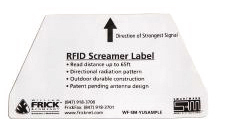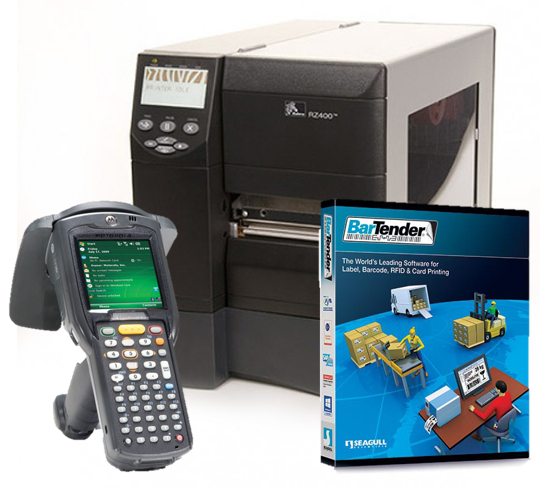Frick Introduces Two New SmartMark RFID Tags with Exceptional Read Ranges
 Frick expands its SmartMark product line with the addition of two new innovative RFID tag solutions. These economical passive UHF RFID tags offer exceptional read ranges for use in a variety of applications. Use with a standard RFID reader-no special equipment or battery-powered tags required.
Frick expands its SmartMark product line with the addition of two new innovative RFID tag solutions. These economical passive UHF RFID tags offer exceptional read ranges for use in a variety of applications. Use with a standard RFID reader-no special equipment or battery-powered tags required.
The High-Performance Metal Mount RFID tag reads directly on metal surfaces from up to 20 feet away—great for tracking metal assets such as fleet trucks, forklifts and tractors, as well as IT equipment.
The Ultra Long Range RFID tag reads from a whopping 65 feet away, making it the ideal solution for tagging overhead assets such as pole-mounted transformers or cables.
RFID Provides Significant Savings and Accuracy for Hospitals
Hospital administrators are finding that inexpensive and unobtrusive radio frequency identification tags are saving thousands of dollars while increasing quality of care and patient satisfaction.
At the brand-new, 58-bed Texas Health Harris Methodist Hospital Alliance in Fort Worth, everything that moves is being tagged, including high-value assets, wristbands on patients and the badges of all staff members.
Over the last year, RFID has saved the Texas Health Alliance $65,000 per month just in rental fees, said Kathi Cox, a project coordinator at the hospital’s parent company Texas Health Resources.
RFID Printing: Now More Reliable and Affordable
 It has been over 40 years since the first RFID device was patented. In its early stages, it was seen as unreliable and far too expensive to adopt over barcode technology. However, more recently companies are starting to adopt RFID technology due to its improvements in readability and cost effectiveness. With these enhancements, companies are seeing the benefits of RFID over barcodes. For example, organizations conducting inventory counts or accounting for high value assets using barcode technology must scan each barcode individually, which requires a considerable amount of time and resources. Whereas RFID readers allow for mass data capture. Additionally, RFID provides real-time, accurate data, which offers tremendous advantages in several industries.
It has been over 40 years since the first RFID device was patented. In its early stages, it was seen as unreliable and far too expensive to adopt over barcode technology. However, more recently companies are starting to adopt RFID technology due to its improvements in readability and cost effectiveness. With these enhancements, companies are seeing the benefits of RFID over barcodes. For example, organizations conducting inventory counts or accounting for high value assets using barcode technology must scan each barcode individually, which requires a considerable amount of time and resources. Whereas RFID readers allow for mass data capture. Additionally, RFID provides real-time, accurate data, which offers tremendous advantages in several industries.
One facet of RFID that has helped simplify the technology and lower the costs is RFID printing. Instead of investing in more costly RFID tags that are typically overkill, companies have found that RFID labels (“Smart Labels”), which are adhesive labels embedded with RFID inlays, are suitable for their requirements. Thus, organizations have the freedom to print their own RFID labels by investing in a RFID printer and RFID label software, both of which have the ability to print barcodes too.
RFID Basics with Motorola – Infographic
RFID has been a buzz word in the auto-ID industry for some time now and is being adopted more everyday by businesses looking to improve efficiency and visibility in their operations. With any new technology, there can be a lot of questions when learning how it works and what components are needed in a system. Â This infographic is a great primer and starting point on the very basics of what is involved in an RFID system and the variety of Motorola readers available to get the job done.
Like any technology, there will probably more questions as you learn more so feel free to contact us at BarcodesInc to see how RFID can improve your daily operations.
QuikQ Installs More Than 1,000 UHF RFID Systems At Fueling Stations

QuikQ has announced that it has installed more than 1,000 of its SmartQ systems at truck stops and travel centers throughout the United States. The SmartQ cardless fueling system leverages EPC Gen 2 passive ultrahigh-frequency (UHF) RFID tags (employing Impinj Monza 4 RFID chips) that can be affixed to trucks or trailers so that the vehicles can be identified while pulling into fuel lanes at truck stops. Once a vehicle is identified via an Impinj reader wired to as many as to four antennas mounted above the lanes, the system can automatically identify that truck, after which its driver can begin fueling without having to swipe a card or enter data on the pump’s keypad.
Love’s Travel Stops and Country Stores has implemented the system at more than 200 of its fuel stations to date. TravelCenters of America (which operates 165 sites) has also installed the solution, QuickQ adds, and is nearly finished with that deployment. In addition, QuikQ reports, many independent truck stops and travel centers are utilizing its SmartQ system. Acknowledging QuikQ’s growth, Impinj named the company its North American VAR Partner of the Year.
Why Use RFID Technology for Baggage Handling?
Most airlines struggle day to day with a variety of issues related to survival—issues such as unpredictable fuel costs, uncertain global economies, and tight finances. To combat these challenges, airlines continuously seek to better their operations, and RFID technology is at the forefront of process improvement.
RFID technology can aid and assist in multiple areas to reduce costs and increase operating revenue through improved asset visibility, consumable inventory management, food and beverage delivery management, retail item inventory, sales management, and baggage handling efficiency. This white paper addresses baggage handling specificaly.
Estimates by the International Air Transport Association (IATA) put mishandled baggage costs at approximately $US 2.5 billion for 2009 alone-equivalent to the cost of nearly 50 Boeing 737-600s. This industry problem spans cities, regions and continents. While many assume full participation by all parties is necessary to completely rectify the problem, RFID-enabled baggage tagging efforts already in place show that local or regional implementation of RFID on baggage can have significant benefit, resulting in improved service, substantial cost reductions or savings, and increased customer satisfaction.
Integration of RFID Smart Labels for Third Party Logistics
Industry Need
Effective warehouse management involves the control and monitoring of movement of materials including receiving, storage, picking, staging, and shipping. The increased use of outsourcing these activities has given rise to the rapid growth of third party logistics or 3PL. 3PL providers typically specialize in integrating warehousing and operation services that can be scaled and customized to a customer’s requirements. The use of 3PL has become a cost effective way for many businesses to reduce supply chain costs and increase customer satisfaction. With any logistics process, opportunities for human error exist resulting in misplaced or mis-directed inventory. However, with 3PL providers handling inventory for a multitude of customers, high levels of accuracy and efficiency as well as visibility within the operation have become critical requirements.
Continue reading »
Intermec Advanced RFID Extensions (ARX)
Intermec introduces the first tag motion software toolkit in a standardized reporting format. Intermec Advanced RFID Extensions (ARX) effectively identifies RFID tags of interest and discriminates surrounding tags, providing customers and software integrators the tools to essentially eliminate false-positive reporting of tags.
Getting the Most out of RFID
RFID provides business benefits and a strong ROI for many applications including asset tracking, materials management, and inventory control. Many processes for identifying objects and recording their movements can be automated by RFID. Unattended readers ensure that asset and inventory movements are recorded and alerts issued if the material is moved to the wrong place or at the wrong time. With a well designed RFID system you know all the intimate details of where everything is, where it’s been and where it needs to go. By making your systems smarter, you will be able to:
- Realize huge improvements in asset and inventory visibility
- Resolve problems right when they occur
- Reduce capital and operations expenses
- Increase flexibility of your data collection systems
- Achieve new levels of productivity
RFID automated processes rely on the accuracy of reading the right tags: those that pass through a portal, are on a forklift, or are passing by a checkpoint on a conveyor. Because an RFID reader indiscriminately reads all of the tags that it activates, the presence of stray tags, such as those that pass through a nearby portal or are stationary on nearby racks or pallets, complicates the identification of the true tags of interest versus those that are not part of the process in action.
Continue reading »
RFID Chip-Based Serialization for Retail
An alternative to IT solutions for managing item-level tagging
Item-level radio frequency identification (RFID) using standard Electronic Product Codes (EPCs) is rapidly becoming a key factor in improving retail inventory management. The main driver for adoption is quite simple—taking inventory with RFID is 25 times faster than with bar codes. RFID is faster for two reasons. First, it does not require line of sight access to the tag. Second, the person operating the reader does not have to ensure that they only scanned each tag once.
The key difference is that RFID uses radio waves to count large numbers of tags simultaneously, even if a stack of garments covers the tags or if they are inside a box. During the inventory process, readers often scan each tag several times. For this reason, accurate counts are only possible if each tag carries a unique serial number. In addition to rapid counting, serialization enables the tracking and tracing of individual items throughout the product lifecycle—an additional benefit for some product categories.
As major retailers like Walmart, J. C. Penney, and Macy’s roll out item-level RFID, brand owners must find a low-cost, reliable way to implement serialization. Because serialization is new for most apparel suppliers, it has the potential to be disruptive to existing packaging and labeling business processes. Chip-based serialization is a way to avoid disruption by IT projects, constrained supply chains, and extra serialization costs.
Serialization can be regarded as an IT problem that requires an enterprise software solution to allocate and distribute serial numbers, but it doesn’t have to be. Chip-based serialization is a non-IT alternative that preserves sourcing flexibility and uses the existing business process for tagging and ticketing. To help retailers understand serialization, this paper overviews EPC concepts for item-level RFID, reviews IT-based approaches to serialization, and introduces chip-based serialization as an attractive solution.





